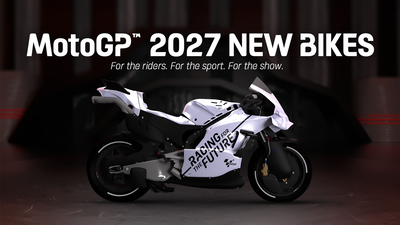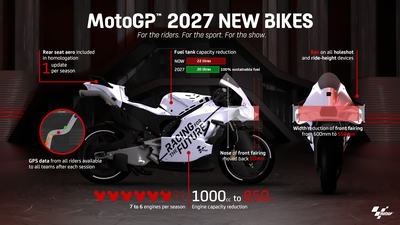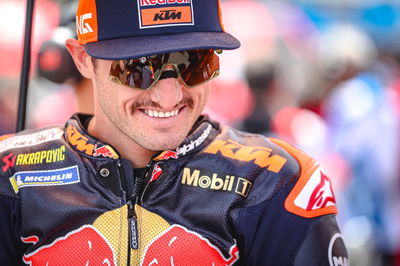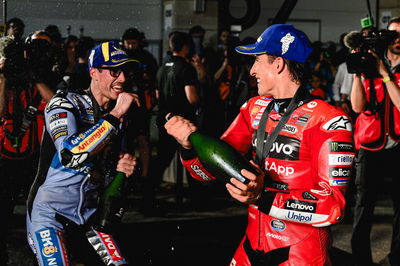MotoGP confirms 2027 regulations - here they are...
Here are the 2027 MotoGP regulations for engines, fuel, aerodynamics, ride-height and hole-shot devices, GPS data and concessions

MotoGP will introduce new bikes from 2027, with new regulations set to make the sport safer, more sustainable and even more spectacular.
The new machines will be more road relevant and more efficient, powering global sustainability, and are designed to create even better racing and even more overtaking.

Engines
From 2027, engine size will be reduced from 1000cc to 850cc. This will decrease top speeds, making the sport safer, and increase mileage, making it more efficient and sustainable.
The maximum bore will reduce from 81 to 75 millimetres, which will also limit performance. This makes the engines more road-relevant at the same time as ensuring they keep the characteristics that make MotoGP as spectacular as it is.
To make the sport even more efficient, the maximum number of engines allowed for each rider in a season will also reduce, from seven to six.
Fuel
As already announced, MotoGP will race with 100% sustainable fuel from 2027 – rising from the minimum 40% the sport has raced with since 2024.
As part of the new regulations, fuel tank capacity will also reduce, from 22 litres to 20, and riders will be allowed to use 11 litres during the Tissot Sprint.
Aerodynamics
Aerodynamics will be reduced and more tightly controlled from 2027, with the aim of minimising their negative effects. The width of the top of the front fairing will be 50mm narrower and the nose will be pushed back 50mm, reducing the effect of aero where it matters, on the straights and the braking areas. This will create even closer racing, with even more overtaking.
At the back, the aero behind the rider will be part of the homologation from 2027, and teams will only be allowed to update that once per season to control costs.
Ride-height and hole-shot devices
In the new era from 2027, all ride-height and holeshot devices will be banned. That will control performance and make the sport safer, especially during race starts. This will also give even more importance to the skill of each rider, just like aero, is aimed at increasing their ability to overtake.
GPS data
To level the playing field even further, GPS data from all riders will be available to all teams after each session. Providing data to all competitors offers better opportunities to progress for the less performing teams and riders, and at a controlled cost. Access to this range of data will help make the sport safer, and it will also increase the level of insight available to fans around the world.
Concessions
The current concession system, introduced at the end of the 2023 season, will continue – but as the new technical regulations come into force in 2027, all manufacturers will start the season in Rank B. They will then be assessed again mid-season, in summer 2027, and can change rank up or down to have access to more or less concessions. This reactive system means manufacturers’ performance is taken into account from Day 1, keeping the playing field as close as possible as a new era begins.
Technical regulations from 2027
The Grand Prix Commission finalised the 2027 technical regulations last week in Jerez.
MotoGP Class Technical Regulations – Effective Season 2027
1.9.1/2.2
MotoGP class engine displacement will reduce from 1000cc to 850cc. The maximum cylinder bore will reduce from 81mm to 75mm. Engines will remain 4-stroke only, with 4 cylinders.
2.4.2 Concessions
Manufacturers who have raced in 2026 will start the 2027 season in Rank B. Rankings will be revised at the mid-season checkpoint in 2027, based on the first part of the 2027 season results only – 2026 results, before the regulation changes, won't be counted. The regular ranking system will resume at the end-season checkpoint at the end of 2027. Any manufacturers who have not raced in 2026 will start 2027 season in Rank D. Their rankings will also be revised at the mid-season checkpoint in 2027, based on the first half of the 2027 season.
2.4.3.3 Engine durability
The number of engines available for use by each permanent contracted rider will reduce to 6 engines per season (up to 20 races), or 7 engines per season in the case of 21 or 22 races on the calendar. Manufacturers in Concessions Rank D will continue to be able to use two additional engines per rider per season.
2.4.3.5 GPS
GPS data from all riders will be made available to all teams at the end of each session.
2.4.3.9 Transmission
In the MotoGP class the total number of gearbox ratios (pairs of gears) permitted will reduce to 16, plus 4 different overall ratios for the primary drive, for each season.
2.4.4.1 Minimum weight
The minimum bike weight in the MotoGP class will be 153kg.
2.4.4.4 Suspensions and dampers
No ride height devices of any kind will be permitted, including “holeshot” devices activated solely for race starts.
2.4.4.5 Fuel Tanks
Fuel tank capacity will be reduced to 20 litres for Grand Prix races and a maximum of 11 litres will be permitted for the Sprint.
2.4.4.7 Reduction of aero surfaces
The maximum permitted width of the high portion of the front fairing Aero Body will reduce from 600mm to 550mm, the maximum rear end height will reduce from 1250mm to 1150mm, the foremost point of the front fairing (nose) will be moved back by 50mm, and the rearward taper of the front fairing aero appendices will also narrow.
Homologation of aero surfaces
The rear end of the machine – any aerodynamics behind the rider – must be homologated as part of the Aero Body. Manufacturers will be permitted to make one update per season.
2.4.5.1 Fuel and Oil
The use of 100% non oil-refinement origin fuel is confirmed from 2027. The FIM, together with MSMA and the MotoGP fuel suppliers, will clarify all technical details via the TWG1 working group, including representatives from Dorna and IRTA, beginning in May 2024.












